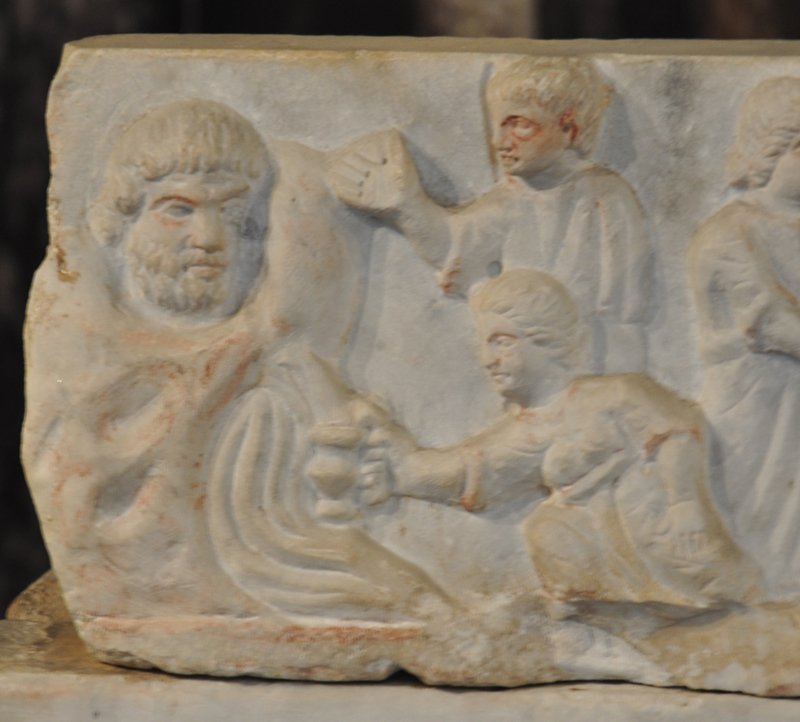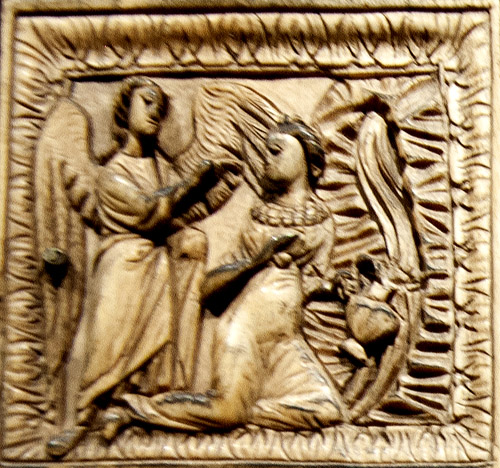The Sarcophagus of Adelphia: Detail, left end of the lid

From the Catacombs of St. John, Syracuse, Sicily
Second quarter of the 4th century or later.
Marble
Archeological Museum, Syracuse, Sicily
Some scholars take this to be the Annunciation; others say it is the decedent drawing from the well of Wisdom. The former is surely the more elegant of the interpretations, as it corresponds neatly to the narrative in the Gospel of pseudo-Matthew in the Protevangelium of James, where the "angel of the Lord" addresses Mary while she is out filling a pitcher with water. The woman bending at the well with a pitcher would be Mary, bareheaded because a virgin and wearing a simple belted tunic. At this early stage of iconography the angel behind her has no wings, like the angel in
this Sacrifice of Isaac panel
from a sarcophagus of the same century. The big head should be a personification of the well. Strange as it seems to modern perception, it was common for paleo-Christian images to represent a body of water both directly and by way of a bearded personification, as in
this Baptism of Jesus in Ravenna.
 Another strong indicator that this scene is from the apocryphal Annunciation accounts is its close similarity to an undoubted Annunciation image on a 5th-century ivory diptych from Ravenna. Like the sarcophagus panel, the ivory has Mary kneeling at a spring that flows sinuously from a rock and fills a footed pitcher with one handle. The angel's greeting is pictured in both by means of a raised right hand.
Another strong indicator that this scene is from the apocryphal Annunciation accounts is its close similarity to an undoubted Annunciation image on a 5th-century ivory diptych from Ravenna. Like the sarcophagus panel, the ivory has Mary kneeling at a spring that flows sinuously from a rock and fills a footed pitcher with one handle. The angel's greeting is pictured in both by means of a raised right hand.
The alternative interpretation holds that the woman at the spring is the decedent, Adelphia herself, who in the next two scenes will be taken into the presence of Sophia, the personification of Wisdom. This first scene would have her drawing water from the well of Wisdom. The bearded man would be the "Ancient of Days," the name given to God in Daniel 7:9,13. This is the most strained aspect of the interpretation, because it does not give a satisfactory explanation for the standing male figure, and in explaining the big head it has to go outside the allegory to an obscure passage in scripture that is not evidenced in other sarcophagi.
View this image in full resolution.
View the entire sarcophagus.
View the next scene on the sarcophagus lid.
Read more about images of the Annunciation.
Photographed at the Syracuse Archeological Museum by Richard Stracke, shared under Attribution-NonCommercial-ShareAlike license.
 Another strong indicator that this scene is from the apocryphal Annunciation accounts is its close similarity to an undoubted Annunciation image on a 5th-century ivory diptych from Ravenna. Like the sarcophagus panel, the ivory has Mary kneeling at a spring that flows sinuously from a rock and fills a footed pitcher with one handle. The angel's greeting is pictured in both by means of a raised right hand.
Another strong indicator that this scene is from the apocryphal Annunciation accounts is its close similarity to an undoubted Annunciation image on a 5th-century ivory diptych from Ravenna. Like the sarcophagus panel, the ivory has Mary kneeling at a spring that flows sinuously from a rock and fills a footed pitcher with one handle. The angel's greeting is pictured in both by means of a raised right hand.
